Royal de Luxe: Theatre of giants breathes new life into Nantes
- Published
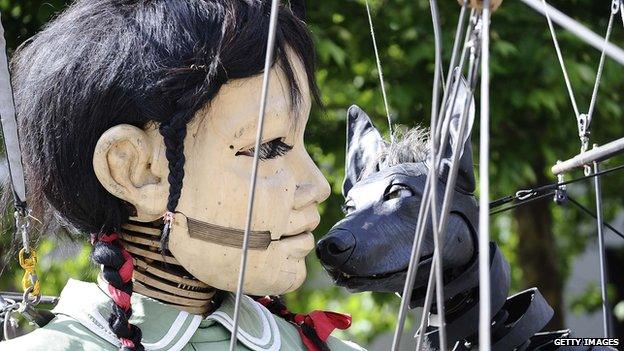
The Royal de Luxe theatre company has two golden rules: All shows must be performed outdoors, rain or shine, and they must always be free to the public.
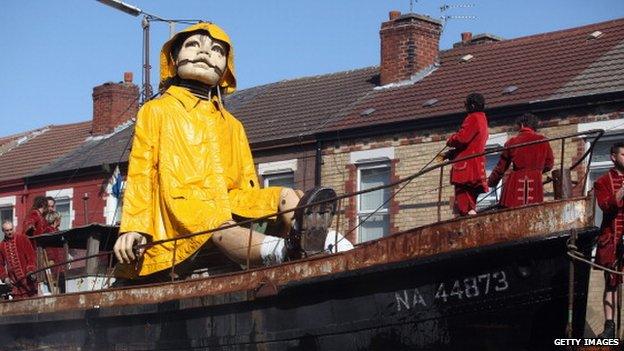
Royal de Luxe performed The Sea Odyssey on the streets of Liverpool in 2012, marking the centenary of the sinking of the Titanic.
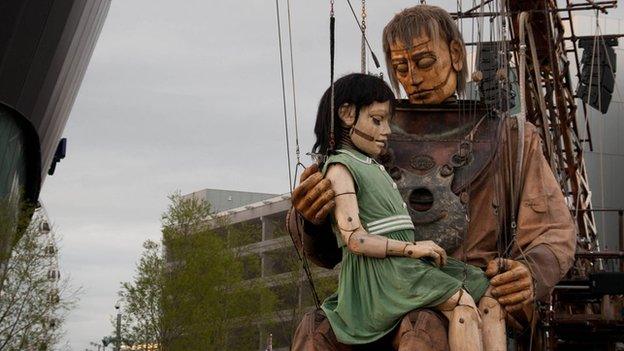
The Sea Odyssey was inspired by a letter written in 1912 by a 10-year-old girl from Liverpool to her father, who died on the Titanic.
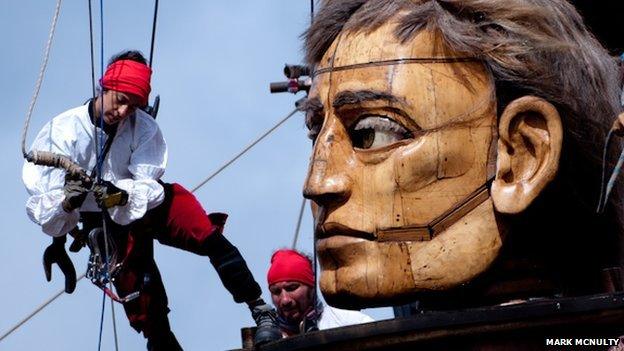
Dozens of people are needed to work the ropes of "The Giants" to operate them.
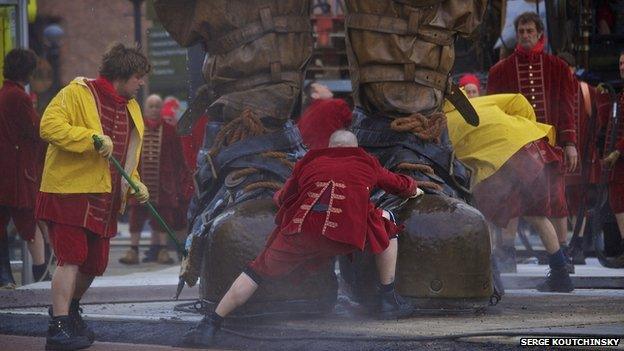
"Sometimes we really need to see things with greater dimensions than ourselves - to remember that after all we are only human beings." - Jean Luc Courcoult, artistic director, Royal de Luxe.
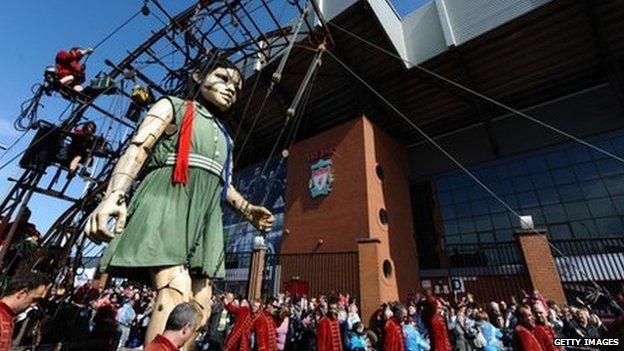
This giant girl, standing nine metres (30ft) tall, walks past the home of Liverpool football club

Commuters on their way to work pass a giant fork stabbing a car in the Royal de Luxe show called Traffic Jams, which was performed in Nantes, western France.
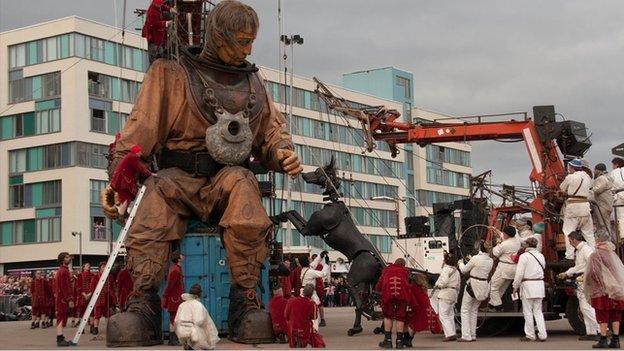
This giant diver's hair is made from horsehair, and its eyelashes are made from broom hair. His eyes are street lamps which are moved by small motors.
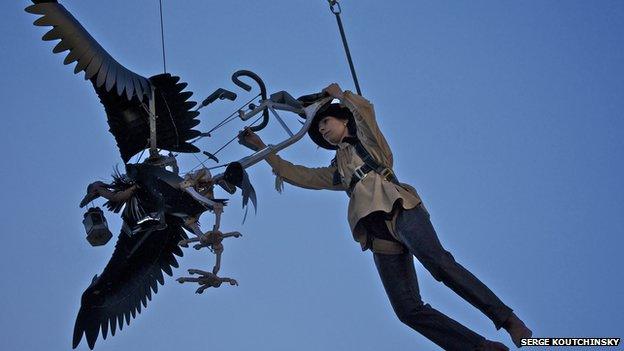
A vulture from Rue de la Chute - Fall Street - the new Wild West production by Royal de Luxe.

Rue de la Chute also features actors - the show pays homage to Calamity Jane.
Royal de Luxe is a street theatre company known around the world for its giant marionettes. It has also helped revive the declining French port city of Nantes, turning it into a beacon of contemporary French culture.
In the 15th-Century courtyard of the Chateau des Ducs de Bretagne in Nantes I almost trip over an enormous horse lying on its side. It appears to be dead. The eyes are cloudy and the mouth is open in a rictus grin.
But the horse is not real. It is an oversize prop in the latest production by one of the world's most innovative street theatre companies, Royal de Luxe.
As I admire a huge vulture with rubbery wings, an actor in a cowboy costume walks past and then fires a few rounds of noisy blanks from his pistol. "Just testing!" he grins.
Rue de la Chute - Fall Street - is a Wild West extravaganza and the latest production by the theatre company which has two golden rules: all shows must be performed outdoors and they must always be free to the public.
Despite the leaden grey skies, there is already a long line of people queuing on the drawbridge to get into tonight's performance.
The rain starts about half an hour into the show and soon it is bucketing down. I cower under a flimsy umbrella and some of the audience leave, but the actors soldier on, despite their melting makeup and soaking wet costumes.
Later they explain that they are inspired by their artistic director, Jean Luc Courcoult, an energetic man in a flowery shirt and pork pie hat.
He puffs out his cheeks in an unmistakably Gallic fashion and shrugs. "We're at the mercy of the elements, but so what!"
Over coffee, in his house next to Nantes Botanic Gardens, he tells me more about his company, who call themselves a collection of "inventors, stuntmen, poets and scrap metal workers."
'The Giants'
The production I have just seen, which is confined to the courtyard of a large castle, features actors speaking and singing. But Royal de Luxe is perhaps more famous for its marionettes, which can be up to 12 metres (40ft) tall. They take audiences on long promenades through streets, neighbourhoods, and city centres.
Earlier this year, huge crowds were entranced by Royal de Luxe's Sea Odyssey, in which three giant marionettes played out their story on the streets of Liverpool to commemorate the Titanic disaster. In 2006, the company's 42-tonne mechanical elephant brought central London to a standstill.
Jean Luc Courcoult never refers to these creations as just puppets - he calls them "the giants" and hopes audiences will connect to them emotionally. He wants spectators to feel that they are as real as the dozens of people who tug on the ropes that work them.
Indeed Royal de Luxe's giant operators call themselves Lilliputians, after the race of tiny people in the novel Gulliver's Travels.
Polly Moseley, who accompanies us to Courcoult's house, worked with Culture Liverpool to organise the Royal de Luxe visit to the English city.
She says hundreds of thousands of Liverpudlians, who may not count themselves as theatre fans, readily identified with the Lilliputians and immediately took the giants to their hearts.
"The fact that the company's made up of engineers and several strong men who have to put a lot of physical exertion into working the giants - people just loved that".
"There was one woman in Anfield who told me that she never really communicated with her 16-year-old son, who was always in his bedroom on his computer. And when he saw the giants on the first day she just couldn't tear him away. He followed them everywhere - 23 miles over three days."
Courcoult says the best thing about the giants is that they allow adults to become children again: "When I was little I looked up at my dad and he was huge! My mum too.
"We create a new mythology inside cities where people can recover their innocence because they see characters which are so much bigger than them. And sometimes we really need to see things with greater dimensions than ourselves - to remember that after all we are only human beings."
Revival of Nantes
Surprise is a key ingredient in Royal de Luxe's shows, so they often go to great lengths to avoid media attention.
One piece called Traffic Jams was put on between 06:00 and 10:00 in the morning, when commuters were hurrying to work.
It featured bizarre stunts such as tramps asleep on bonnets of cars, a giant fork stabbing a truck and a couple sitting nonchalantly in a car which had its roof ripped back with a colossal can opener.
"Imagine stopping at a red light," says Courcoult, "and seeing a man and woman up to their necks in peas and carrots! You'd think you were still dreaming and pinch yourself. But if the pictures had already been in the newspapers, it would spoil everything."
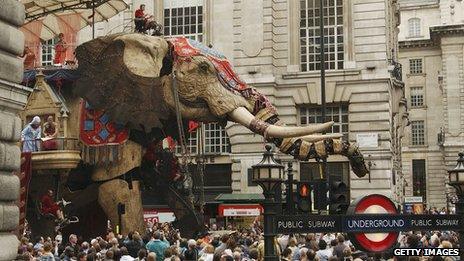
The Royal de Luxe giant mechanical elephant plods through London in 2006
The company started in 1979 in Aix-en-Provence and later moved to Toulouse in south-west France.
Then in October 1989, Royal de Luxe received an offer they could not refuse from the man who is now France's prime minister, Jean-Marc Ayrault. At that time Mr Ayrault was mayor of Nantes and offered the company generous funding, a cargo ship and the use of a disused warehouse on the banks of the River Loire to lure it to his city.
"Ayrault had a very strong political will to promote culture in this city," says Jean Blaise, the mayor's former right-hand-man.
"When Ayrault first arrived, this was a sad town because it had lost its raison d'etre. Like Liverpool, it was once famous for shipbuilding.
"So he decided to invest heavily in culture to bring the place back to life. Twenty years later that policy has really paid off - we have lots of new businesses and every year more visitors."
Polly Moseley agrees: "The arrival of Royal de Luxe brought a civic pride to the city [Nantes] when it needed it, and an international reputation which is now very much associated with the big machines, with the giants and the elephant.
"People know these creations are made here in Nantes and that's had a knock-on effect of starting to attract other innovative artists from elsewhere."
Mr Blaise is the director of Le Voyage a Nantes, a trail linking all the city's cultural highlights and an open-air art exhibition featuring the work of nearly 100 artists.
Some installations are unexpected, such as a building wrapped in metal, which makes tinkling noises and emits birdsong. It is by the sculptor and musician Ralph Julius and is described in the guide book as an "audible facade to an existing building".
For many visitors the highlight is a massive animatronic elephant, which can carry 45 people on its back as it stomps around the former shipyards. Children run and squeal with delight when it sprays water from its trunk.
The elephant may have been inspired by Royal de Luxe but it belongs to another group called Les Machines de l'Ile, who have just created a three-tier roundabout in the old shipyard, featuring sea creatures from the underwater world of Jules Verne, a native of Nantes.
"This is simply astonishing, amazing isn't it!" says a man sitting at a cafe table with his wife. "We came all the way from Northallerton in Yorkshire and it was well worth the journey."
Listen again to On the French Fringe via the BBC Radio 4 website.
- Published21 April 2012
- Published20 April 2012